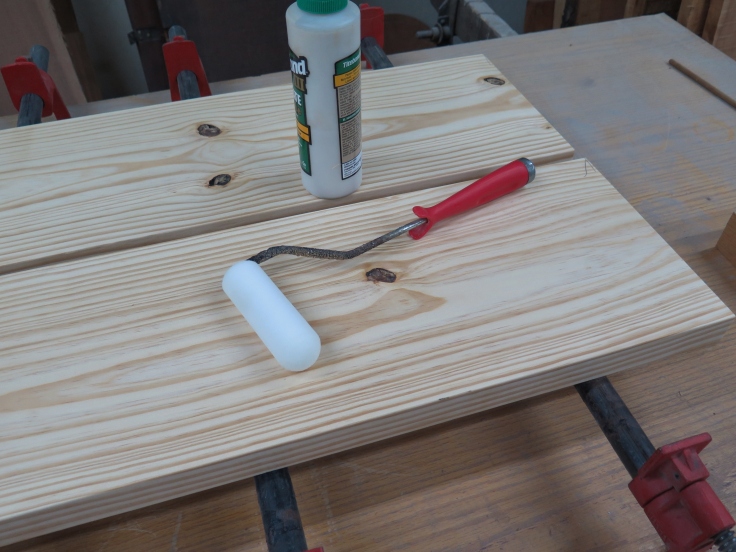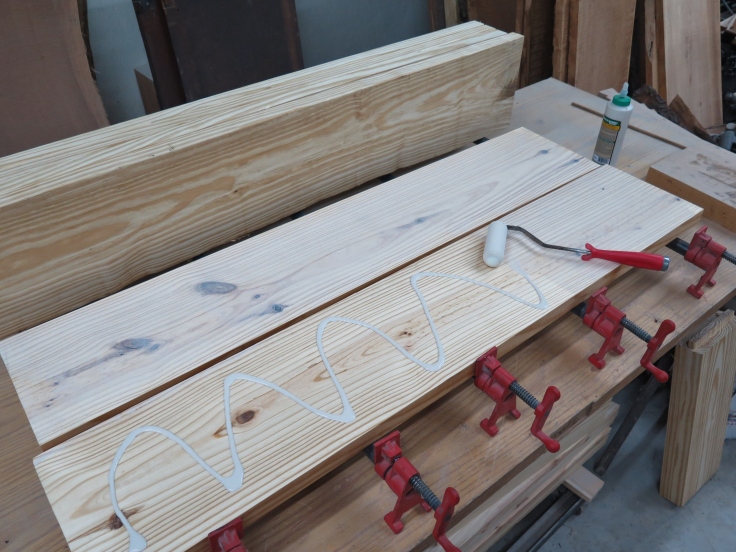I hate glue ups, particularly when using PVA type glues. The nagging sense of urgency thru the whole process and trying not to make too big of a mess of the project or yourself just ain’t much fun. Anything that makes the process go a little faster or easier is always a good thing
Today I was laminating 2 x 10 yellow pine for the back vise supports for a Moravian workbench class at The Woodwright’s School coming up next week and snapped a few photos of the process I use.
When face laminating boards I use a 4″ foam paint roller to spread the glue. These things are cheap and available at any hardware store or home center. This is not a new idea but I rarely see anyone using them; really not sure why. 
Squirt the glue onto the boards in a zig-zag pattern and then roll it out. The roller allows you to spread a perfectly even coat of glue quickly with less open time. The cost of the roller is more than paid for in the glue saved by not having so much excess squeezed out when the clamps are tightened. With less squeeze out there is also little to no mess to clean up when your done.
If you are doing glue ups over several days, wrap the roller in a plastic grocery bag and put it in the fridge, it will be ready to go when you need it next. The glue will not set because of the lack of air and the cold; you can store it up to month this way. When you are done the roller can be washed out and reused.
-Will Myers
I agree that glue-ups, even simple ones, can be nerve wreaking. Unpredictable hip cups may still happen even after you have done dry fitting. However, the roller thing does not help with any glue-up complications as it is just an applicator. You can spend twice as long to apply glue on the pieces but as long as the two mating pieces are not in contact, you are not in danger. The problem could arise only after you put two glue-filled surfaces together.
There is nothing wrong with using a roller, but it is not a savior in any aspects.
LikeLike
No, the roller is not a miracle fix for glue up problems. My intended meaning is it speeds up lamination of wide board faces which means less open time, uses less glue, and not nearly as messy. It is simply an efficient method of application.
LikeLike
doing some laminations this week…gonna give it a try. Seems like a solid technique and I know you’re speaking from solid experience. Thanks for sharing.
LikeLike
I hope commenting on older posts is okay. A couple months ago I was doing some big glue-ups of SYP to make a workbench top. The top was made in three sections, each section comprised of five boards and then the sections glued together. The first section was nerve-wracking. For the second section, I had the same idea and decided to use the 4″ foam nap and roller I use for milk paint.
It definitely went on faster, but I came to a different conclusion concerning the amount of glue. The foam ended up soaking up and holding on to so much glue that I felt like I had to use more glue than usual to compensate. I then saw all that glue go down the drain during cleanup.
There is at least one difference. I was using Titebond Original and by your photo you’re using Titebond III. The foam nap might be different too.
For the third section, I went back to the paintbrush I normally use. Maybe I’ll try it again with different glues and see how I like it. Plus, I don’t remember if there was more, less, or a typical amount of squeeze out so I’ve got a couple things to consider while I experiment.
LikeLike